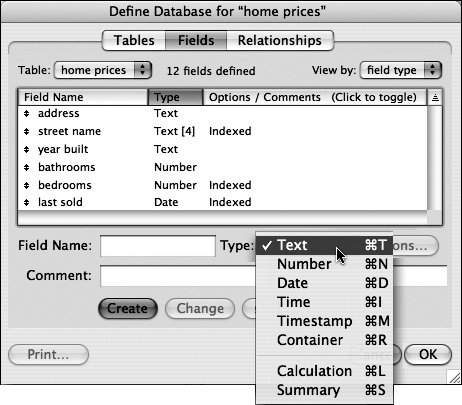| FileMaker's eight different types of fields are assigned using the Type drop-down menu in the Define Database dialog box (Figure 9.1). For step-by-step instructions on using this dialog box, see To define a field on page 96. (See Storage options on page 104 for information about global fields.) But first, here's a quick rundown on the best uses for each field type: Text: A text field can contain up to 1 billion characters (letters, symbols, and numbers as text). Text fields can be sorted (usually AZ or ZA) and used in formulas. Even items that might not at first blush seem to be text sometimes should be placed in text fields. For example, telephone numbers usually contain non-numeric hyphens or slashes, and so are best made into text fields. Number: A number field can contain up to 800 characters (numbers or other characters, which will not be treated as numbers). Number fields can be sorted (1100 or 1001) and used in formulas for calculations and summary fields. Also used for Boolean values (0, 1) to represent true/false or yes/no. Date: Can contain only dates in the format of 1/1/1975 and 12/28/2008. They can be sorted (earliest-latest or latest-earliest) and used in formulas for calculations and summary fields. Be sure to use four digits for years. For more, see Validation options on page 102. Time: Can only contain the hours, minutes, and seconds of a time. Time fields can be sorted (earliest-latest or latest-earliest) and used in formulas for calculations and summary fields. Timestamp: Contains a specific date and time and can be used as a reference point in calculations. Container: Holds graphics, photos, sounds, movies, QuickTime multimedia files, or Object Linking and Embedding (OLE) objects (Windows only), or documents (PDFs, Microsoft Word or Excel files). Container fields cannot be sorted, but can be used in formulas for calculations and summary fields. While container fields cannot contain text or numbers, you can createand sortrelated text or number fields to describe a container field's contents. See Understanding Formulas on page 114 and Using Calculation and Summary Fields on page 119. Calculation: These fields display the results of calculations made using other fields and so cannot have values typed directly into them. The result can be text, a number, date, time, timestamp, or container. With the exception of summary functions, calculation fields operate on data within single records. See Using Calculation and Summary Fields on page 119. Summary: Like calculation fields, summary fields cannot have values entered directly into them. Instead, they display summary values based on other fields in the database. In general, summary fields operate on data from a group of records. See Using Calculation and Summary Fields on page 119. Figure 9.1. Choose your field type using the Type dropdown menu in the Define Database dialog box. 
|
